Che cos'è il MACD: come leggerlo e utilizzarlo
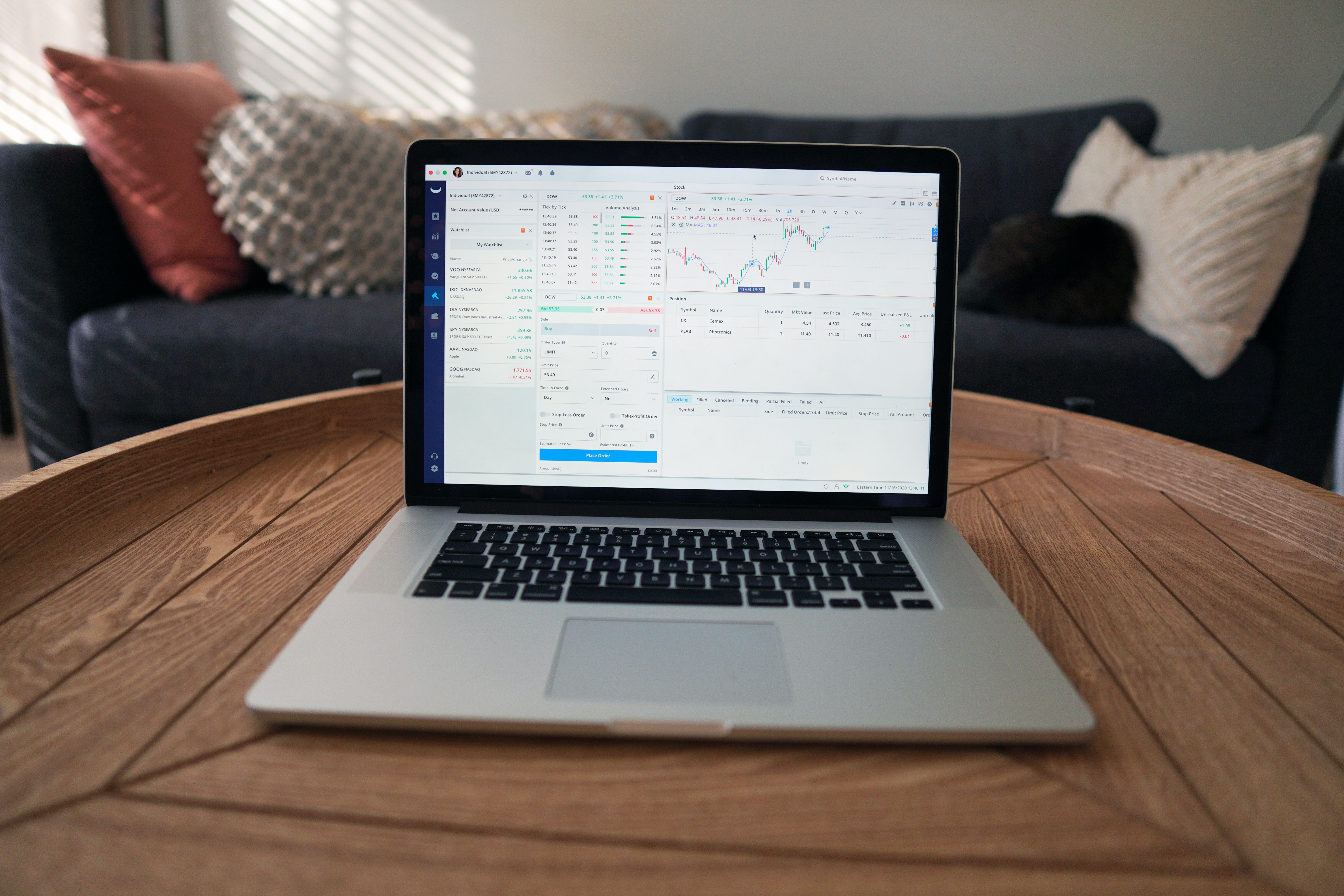
Le strategie di trend following di successo richiedono molto più che il semplice monitoraggio dei movimenti dei prezzi; richiedono un timing preciso e una chiara conferma del momentum. Ogni trader azionario si trova prima o poi ad affrontare la sfida di distinguere i trend di prezzo reali dalle fluttuazioni di breve durata, in particolare quando le condizioni di mercato volatili creano falsi segnali. Questa incertezza porta spesso a operazioni effettuate con tempistiche sbagliate, opportunità mancate e perdite inutili. I trader hanno bisogno di strumenti affidabili che evidenzino quando un titolo è realmente in trend rialzista e li aiutino a determinare i momenti migliori per agire.
L'indicatore MACD affronta questa sfida analizzando la relazione tra le medie mobili a breve e lungo termine. Non solo aiuta i trader a confermare il momentum, ma individua anche le aree di accelerazione al rialzo che possono segnalare una forte performance futura. Se utilizzato in modo efficace, il MACD può trasformare il modo in cui i trader pianificano i loro punti di ingresso, migliorando la strategia complessiva e aumentando la redditività. Identificando tempestivamente i periodi di momentum sostenuto, questo versatile indicatore tecnico fornisce una visione più chiara delle tendenze dei prezzi e la fiducia necessaria per effettuare un acquisto ottimale.
Indice
Punti chiave
MACD: che cos'è?
Indicatore MACD: terminologia chiave
Quali problemi risolve il MACD?
Spiegazione dell'indicatore MACD
Come viene calcolato il MACD? Formula
Come utilizzare l'indicatore MACD
Interpretazione del MACD
Il cheat sheet MACD per i trader di momentum
MACD vs. altri indicatori
Limiti del MACD e considerazioni importanti
Pro e contro del MACD nel trading
Dove trovare l'indicatore MACD?
Conclusione
Domande frequenti
Punti chiave
- L'indicatore MACD combina medie mobili e un istogramma per identificare opportunità di acquisto e vendita nei mercati di tendenza.
- Il MACD è composto da tre elementi: la linea MACD, la linea di segnale e l'istogramma, che lavorano insieme per rivelare i cambiamenti di momentum.
- Gli incroci della linea di segnale e della linea centrale generano i segnali di trading primari per i punti di ingresso e di uscita.
- Le divergenze tra l'andamento dei prezzi e il MACD spesso segnalano potenziali inversioni di tendenza prima che si verifichino.
- Il MACD funziona al meglio nei mercati con tendenza, ma può produrre falsi segnali durante i periodi di consolidamento laterale.
- Questo indicatore tecnico dovrebbe essere combinato con altri strumenti di analisi per decisioni di trading più affidabili.
MACD: che cos'è?
Il Moving Average Convergence Divergence, o MACD, è un indicatore tecnico ampiamente utilizzato, progettato per aiutare i trader e gli investitori a identificare le tendenze dei prezzi e misurare lo slancio del trend. Fondamentalmente, il MACD funziona come un oscillatore che calcola la differenza tra due medie mobili esponenziali: la linea MACD e la linea di segnale.
Quando queste linee si incrociano, divergono o convergono, generano preziosi segnali di trading. Ad esempio, un crossover rialzista può evidenziare un potenziale punto di ingresso, mentre un crossover ribassista può segnalare una possibile debolezza. Il MACD presenta anche un istogramma che rappresenta visivamente la distanza tra la linea MACD e la linea di segnale, rendendo più facile individuare sottili cambiamenti nello slancio.
Analizzando questi crossover e le variazioni dell'istogramma, i trader possono individuare i primi punti di accelerazione all'interno dei movimenti di prezzo in corso. Comprendere come interpretare il MACD consente agli operatori di mercato di anticipare meglio i cambiamenti di tendenza, affinare i tempi di ingresso nel mercato e rafforzare la loro strategia di trading complessiva.
Indicatore MACD: terminologia chiave
Man mano che approfondiamo la descrizione dell'indicatore MACD, è essenziale comprendere alcuni termini chiave che ne costituiscono le basi fondamentali.
- Media mobile: si tratta di un indicatore tecnico fondamentale che fornisce un valore medio per uno specifico strumento di trading in un periodo predefinito. Questo termine aiuta a smussare le fluttuazioni di prezzo, consentendo così ai trader di discernere più chiaramente il trend sottostante.
- Media mobile esponenziale: talvolta denominata "media mobile ponderata esponenzialmente". Questo metodo assegna un peso maggiore ai dati più recenti, fornendo un riflesso più tempestivo dei cambiamenti nella tendenza di mercato. Nel contesto del MACD, entrano in gioco due tipi di medie mobili esponenziali: la linea MACD e la linea di segnale.
- Convergenza e divergenza: si tratta di due fenomeni fondamentali associati a queste linee. Quando le due medie mobili si avvicinano, si verifica una convergenza. Ciò potrebbe suggerire una potenziale inversione della tendenza di mercato. Al contrario, la divergenza si verifica quando queste medie si allontanano, segnalando possibilmente un rafforzamento della tendenza attuale.
- L'istogramma MACD: si tratta di un'altra rappresentazione visiva della differenza tra la linea MACD e la linea di segnale. Quando queste linee si incrociano, i trader spesso lo interpretano come un segnale di acquisto o di vendita, in particolare quando questi incroci avvengono a livello zero.
Comprendere questi termini è fondamentale per un'efficace interpretazione dell'indicatore MACD e per l'applicazione pratica delle strategie MACD nell'ambito del trading. Ricorda, il MACD non è solo un indicatore, ma uno strumento affidabile che, se utilizzato correttamente, può migliorare significativamente la tua analisi di mercato e i tuoi consigli di investimento.
Che cos'è un MACD nel trading?
Nel contesto del trading, il MACD funge da rappresentazione visiva delle dinamiche dell'andamento dei prezzi influenzate dalla volatilità del mercato e dai cambiamenti di momentum. L'indicatore evidenzia cambiamenti significativi nel comportamento del mercato, come il passaggio da condizioni rialziste a condizioni ribassiste, fornendo ai trader chiari punti di ingresso e segnali di uscita. Quando i segnali MACD sono in linea con l'andamento dei prezzi, spesso indicano opportunità di trading ad alta probabilità.
Che cos'è un indicatore MACD e qual è la teoria alla base?
La Moving Average Convergence Divergence funziona come un indicatore ritardato, il che significa che tutti i calcoli derivano dall'andamento storico dei prezzi piuttosto che dalla previsione dei movimenti futuri. Questa caratteristica spiega perché il MACD è "in ritardo" rispetto alle variazioni di prezzo attuali, poiché si basa su medie mobili esponenziali calcolate dai prezzi di chiusura passati per generare segnali di trading.
Quali problemi risolve il MACD?
Gli operatori di mercato spesso faticano a identificare le tendenze sottostanti reali tra le fluttuazioni quotidiane dei prezzi e la volatilità del mercato. Gerald Appel ha progettato il MACD per affrontare questa sfida fondamentale, filtrando il rumore di mercato e rivelando chiaramente lo slancio alla base dei movimenti dei prezzi. L'indicatore risolve il problema della tempistica misurando quando le tendenze accelerano o decelerano, aiutando i trader a distinguere tra correzioni temporanee e cambiamenti di tendenza significativi. Combinando diversi periodi di tempo delle medie mobili, il MACD elimina gran parte della confusione creata dalle tendenze di mercato contrastanti a breve e lungo termine.
Spiegazione dell'indicatore MACD
L'indicatore MACD è un potente strumento che i trader utilizzano per determinare le tendenze e lo slancio del mercato. Composto da tre componenti principali, il MACD non solo è robusto, ma anche altamente versatile.
In primo luogo, la linea MACD viene creata sottraendo la media mobile più lunga (di solito 26 periodi) da quella più breve (tipicamente 12 periodi). Questa linea è fondamentale per identificare la tendenza generale del mercato, indicando lo slancio al rialzo o al ribasso.
Il secondo componente è la linea di segnale, che è una media mobile esponenziale (EMA) della linea MACD stessa, spesso su un arco di 9 periodi. L'interazione tra il MACD e la linea di segnale produce preziosi segnali di trading. Un movimento della linea MACD al di sopra della linea di segnale suggerisce in genere un segnale di acquisto, mentre un movimento al di sotto può implicare un potenziale segnale di vendita.
L'istogramma MACD rappresenta visivamente la divergenza (allontanamento) e la convergenza (avvicinamento) tra la linea MACD e la linea di segnale. L'istogramma mostra valori positivi quando la linea MACD è sopra la linea di segnale, suggerendo un momentum rialzista, e valori negativi quando è sotto, indicando un potenziale momentum ribassista. La dimensione dell'istogramma rappresenta la velocità del movimento dei prezzi, aumentando con l'accelerazione e diminuendo con la decelerazione del movimento dei prezzi.
Come viene calcolato il MACD? Formula
Il calcolo del MACD prevede l'uso di medie mobili esponenziali (EMA) e consiste di tre componenti principali: la linea MACD, la linea di segnale e l'istogramma MACD. I periodi di tempo predefiniti per questi elementi utilizzano solitamente intervalli di 12, 26 e 9 giorni, anche se i trader su piattaforme come MT5 possono regolarli in base alle loro strategie di trading e alle condizioni di mercato utilizzando diverse impostazioni MACD.
Per calcolare la linea MACD, sottrarre la media mobile più lenta (EMA a 26 giorni) dalla media mobile più veloce (EMA a 12 giorni):
Linea MACD = EMA a 12 giorni – EMA a 26 giorni
La linea MACD risultante rappresenta la relazione tra le due EMA. Questa linea oscilla intorno alla linea dello zero e costituisce la base dell'istogramma MACD.
La linea di segnale, che è un'EMA della linea MACD, viene quindi calcolata:
Linea di segnale = EMA a 9 giorni della linea MACD
La linea di segnale funge da trigger per i segnali di trading. Quando incrocia la linea MACD, può indicare potenziali punti di ingresso o di uscita dal mercato, aiutando i trader a valutare la forza e la direzione dei trend.
L'istogramma MACD illustra la differenza tra la linea MACD e la linea di segnale:
Istogramma MACD = linea MACD – linea di segnale
La lettura dell'istogramma MACD può fornire informazioni sul momentum del mercato. Ad esempio, quando l'istogramma MACD si allontana dalla linea dello zero in entrambe le direzioni, segnala che il trend attuale sta guadagnando forza.
Come utilizzare l'indicatore MACD
Il MACD fornisce informazioni preziose sulla forza, la direzione, lo slancio e la durata del trend di prezzo di un titolo, offrendo indicazioni sui potenziali punti di ingresso o di uscita. La comprensione del MACD comporta tre elementi chiave: la linea MACD, la linea di segnale e l'istogramma MACD. Gli incroci tra la linea MACD e la linea di segnale possono indicare punti di ingresso o di uscita ottimali. Ad esempio, quando la linea MACD incrocia al rialzo la linea di segnale, può suggerire un momento favorevole per l'acquisto. Al contrario, quando la linea MACD incrocia al ribasso, potrebbe segnalare un buon momento per vendere.
Interpretazione del MACD
Comprendere come leggere l'indicatore MACD è una competenza fondamentale per i trader. Il MACD è composto da tre elementi principali: la linea MACD, la linea di segnale e l'istogramma. Ciascuno di questi componenti aiuta a identificare il momentum del mercato e i possibili punti di ingresso o di uscita.
Quando la linea MACD incrocia al rialzo la linea di segnale, questo evento è chiamato crossover rialzista. Spesso segna l'inizio di un trend rialzista, il che significa che il momentum del mercato sta probabilmente cambiando al rialzo. In questo momento, le barre dell'istogramma si spostano al di sopra della linea dello zero, confermando visivamente che la linea MACD è ora più forte della linea di segnale. Più alte sono le barre dell'istogramma al di sopra della linea dello zero, più forte potrebbe essere il momentum rialzista.
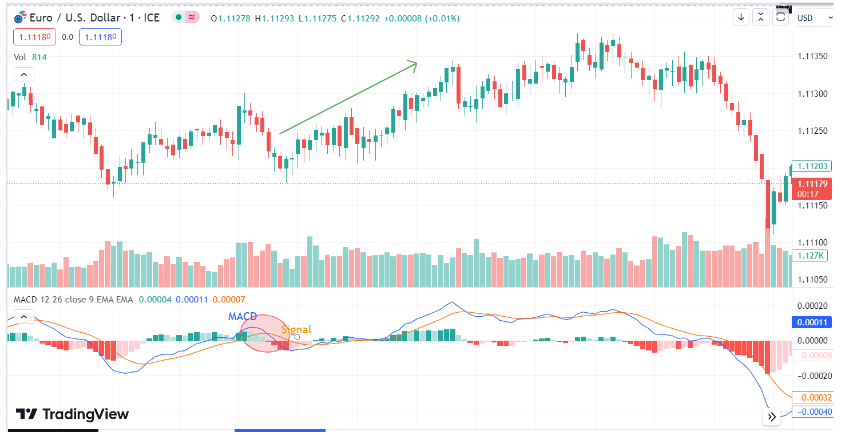
Al contrario, quando la linea MACD incrocia al di sotto della linea di segnale, si forma un segnale ribassista. Ciò indica un potenziale trend al ribasso. In questa situazione, le barre dell'istogramma scendono al di sotto della linea dello zero, indicando che la linea MACD ha perso forza rispetto alla linea di segnale. Barre più lunghe al di sotto della linea dello zero indicano che il momentum ribassista è in aumento.
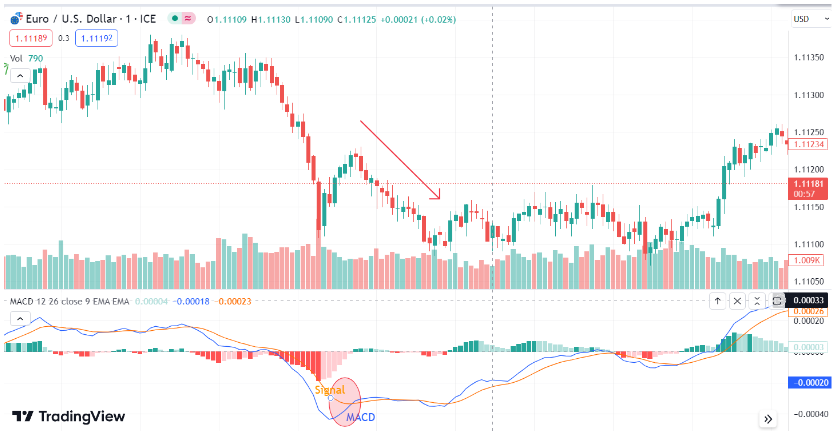
Combinando i segnali della linea MACD, della linea di segnale e dell'istogramma, i trader possono comprendere meglio le condizioni di mercato. Osservare la distanza dell'istogramma dalla linea dello zero può anche aiutare a valutare la forza di ciascun segnale e se lo slancio si sta indebolendo o intensificando.
Nella prossima sezione approfondiremo i dettagli.
Incroci della linea di segnale
Un incrocio della linea di segnale si verifica quando la linea MACD (una differenza calcolata tra le medie mobili a breve e lungo termine) incrocia la linea di segnale più lenta. Quando la linea MACD incrocia al di sopra della linea di segnale, è comunemente vista come un indicatore rialzista, che suggerisce un potenziale trend al rialzo. D'altra parte, quando scende al di sotto della linea di segnale, potrebbe segnalare un trend al ribasso.
Incroci della linea centrale
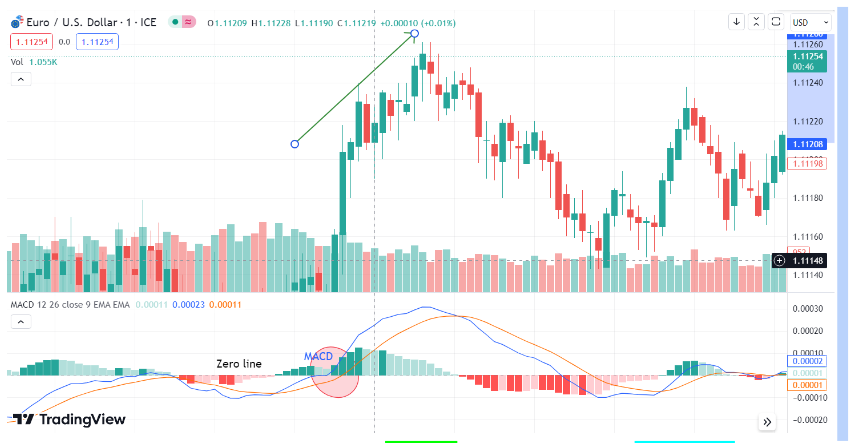
Gli incroci della linea centrale si verificano quando la linea MACD interseca il livello zero, fornendo segnali critici di acquisto o vendita.
Quando la linea di convergenza della media mobile MACD incrocia il livello zero, è generalmente considerato un segnale rialzista, che indica un buon momento per acquistare. Al contrario, se la linea MACD incrocia il livello zero, spesso funge da segnale di vendita, suggerendo una possibile tendenza al ribasso del mercato.
Ricorda che, sebbene l'oscillatore MACD fornisca dati approfonditi, è essenziale corroborare questi segnali con altri indicatori per un'analisi di mercato completa.
Divergenze
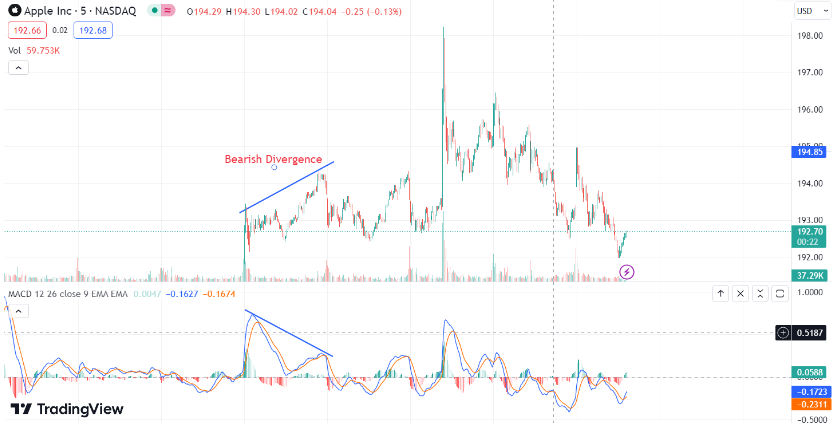
La divergenza MACD si verifica quando il prezzo di un asset si muove in direzione opposta all'indicatore MACD. Ad esempio, se il prezzo forma nuovi massimi mentre il MACD mostra minimi in calo, ciò segnala una potenziale divergenza ribassista, che potrebbe precedere una flessione del mercato. Al contrario, se il prezzo stabilisce nuovi minimi ma il MACD crea minimi in aumento, questa divergenza rialzista potrebbe indicare un imminente movimento al rialzo dei prezzi.
Rapidi aumenti o diminuzioni del MACD
I valori in rapido aumento o calo del MACD indicano una forte divergenza tra la media mobile a breve termine e quella a lungo termine. Quando il MACD aumenta bruscamente, la media mobile a breve termine si allontana da quella a lungo termine a un ritmo accelerato. Questo spesso segnala che il titolo potrebbe essere ipercomprato e vulnerabile a una correzione dei prezzi man mano che le condizioni tornano a livelli normali.
Allo stesso modo, quando il MACD scende rapidamente, la media mobile a breve termine scende ben al di sotto della media a lungo termine. Ciò può indicare un mercato ipervenduto, in cui i prezzi sono scesi troppo rapidamente. Tali situazioni possono precedere un potenziale rimbalzo, poiché il prezzo torna a livelli più tipici. Riconoscere questi rapidi aumenti o diminuzioni del MACD consente ai trader di anticipare possibili inversioni di tendenza ed evitare di entrare in operazioni a prezzi estremi.
Problemi di divergenza
Per quanto l'indicatore MACD sia prezioso per rilevare le divergenze, questa tecnica non è priva di ostacoli. Il trading di divergenza, pur offrendo potenziali segnali di inversioni di mercato, può essere un'arma a doppio taglio.
Una delle principali sfide è che le divergenze MACD possono spesso portare a falsi positivi. Una divergenza potrebbe suggerire una potenziale inversione di prezzo, ma il mercato potrebbe continuare il suo trend, sfidando l'indicazione MACD. Questa discrepanza, in particolare nei mercati volatili, può portare a perdite inaspettate se le operazioni si basano esclusivamente sulle divergenze MACD.
Inoltre, le divergenze possono essere il preludio non solo di inversioni, ma anche di periodi di consolidamento, rendendo complesso l'uso del MACD per il trading di divergenze. Ciò sottolinea l'importanza di abbinare l'analisi MACD ad altri indicatori tecnici e ad un attento esame della linea mediana del mercato.
Il cheat sheet MACD per i trader di momentum
I trader di momentum possono massimizzare l'efficacia del MACD concentrandosi su cinque tipi di segnali chiave che offrono le opportunità di trading con la più alta probabilità di successo. Comprendere questi segnali e il loro contesto di mercato aiuta i trader a evitare le insidie più comuni e a trarre vantaggio dai veri cambiamenti di momentum.
In primo luogo, monitorare gli incroci del MACD sopra e sotto la linea dello zero, poiché questi indicano cambiamenti fondamentali nella direzione del momentum. Gli incroci della linea dello zero spesso precedono movimenti di prezzo significativi, specialmente quando si verificano dopo periodi prolungati su un lato della linea.
In secondo luogo, prestare attenzione agli incroci della linea MACD sopra e sotto la linea di segnale, in particolare quelli che si verificano vicino alla linea dello zero. Gli incroci rialzisti della linea di segnale sotto lo zero spesso offrono eccellenti opportunità di acquisto, mentre gli incroci ribassisti sopra lo zero possono segnalare opportunità di vendita.
Terzo, considera la distanza tra il MACD e gli incroci della linea di segnale dalla linea dello zero. Gli incroci che si verificano più vicini allo zero producono in genere segnali più affidabili rispetto a quelli che si verificano a distanze estreme, che possono indicare condizioni di ipercomprato o ipervenduto.
Quarto, prestare attenzione agli intervalli di negoziazione che possono causare movimenti altalenanti nei segnali MACD. Durante i periodi di consolidamento, l'indicatore può generare più segnali falsi poiché lo slancio oscilla avanti e indietro senza creare tendenze significative dei prezzi.
Quinto, cercate sempre le divergenze tra l'andamento dei prezzi e le letture del MACD. Queste divergenze spesso forniscono i primi segnali di cambiamento di tendenza, dando ai trader di momentum un preavviso delle potenziali opportunità di inversione.
MACD vs. altri indicatori
I trader di momentum spesso confrontano l'indicatore MACD con altri strumenti per capire quale funziona meglio in diverse condizioni di mercato. A differenza degli oscillatori con livelli fissi di ipercomprato e ipervenduto, il MACD opera su base relativa, il che può fornire informazioni uniche se analizzato insieme ad altri indicatori.
)
MACD vs. RSI
Il Relative Strength Index (RSI) è un oscillatore di momentum che misura i guadagni e le perdite medi di prezzo in un determinato periodo. L'RSI genera valori compresi tra 0 e 100, con letture superiori a 70 considerate di ipercomprato e inferiori a 30 considerate di ipervenduto. Questo aiuta i trader a identificare rapidamente potenziali inversioni di prezzo.
Al contrario, il MACD non ha livelli fissi. Si concentra invece sul rapporto tra due medie mobili e la linea dello zero, evidenziando i cambiamenti di momentum piuttosto che i livelli assoluti. A volte, l'RSI e il MACD possono produrre segnali contraddittori, specialmente durante un'azione di prezzo volatile. I trader spesso utilizzano entrambi insieme: l'RSI per individuare gli estremi e il MACD per confermare il momentum più ampio.
MACD vs. Stocastico
L'indicatore stocastico è un altro oscillatore che confronta il prezzo di chiusura di un titolo con il suo intervallo di prezzo in un periodo definito. Valori superiori a 80 indicano condizioni di ipercomprato, mentre valori inferiori a 20 indicano mercati ipervenduti. Il MACD, al contrario, misura la distanza tra una media mobile a breve termine e una a lungo termine, fornendo una prospettiva diversa sullo slancio.
Combinando il MACD con lo stocastico o l'RSI, i trader ottengono una visione più completa delle dinamiche di mercato. Ogni indicatore misura il momentum in modo diverso, quindi utilizzarli insieme può ridurre i falsi segnali e migliorare il processo decisionale. Il MACD è anche uno popolare strumento nel trading Forex e funziona al meglio se abbinato ad altre forme di analisi.
Limiti del MACD e considerazioni importanti
Nonostante la sua popolarità ed efficacia, l'indicatore MACD presenta diversi limiti importanti che i trader devono comprendere per utilizzarlo con successo. Il limite più significativo è la sua tendenza a produrre divergenze false positive durante i consolidamenti dei prezzi, quando l'indicatore può suggerire cambiamenti di tendenza o una potenziale inversione che non si concretizza mai.
I segnali di divergenza della media mobile funzionano al meglio nei mercati di tendenza, ma possono diventare inaffidabili durante l'andamento laterale dei prezzi. Quando i mercati operano in modelli di consolidamento, modelli di intervallo o modelli triangolari, il MACD può oscillare avanti e indietro intorno alla linea dello zero senza fornire indicazioni direzionali significative. Questi periodi richiedono pazienza e strumenti di conferma aggiuntivi.
Un altro limite riguarda la natura ritardata dell'indicatore, poiché i calcoli del MACD dipendono interamente dai dati storici dei prezzi. Sebbene questa caratteristica aiuti a filtrare il rumore di mercato, significa anche che i segnali del MACD spesso appaiono dopo che i cambiamenti di tendenza sono già iniziati. I trader che cercano segnali di ingresso precoci potrebbero trovare che le conferme del MACD arrivano troppo tardi per un posizionamento ottimale.
L'efficacia dell'indicatore varia anche a seconda dei diversi intervalli di tempo: gli intervalli più brevi producono più segnali, ma anche più falsi positivi. Gli intervalli più lunghi forniscono segnali più affidabili, ma con minore frequenza, creando un compromesso tra quantità e qualità dei segnali.
Per ovviare a queste limitazioni, molti trader combinano il MACD con indicatori che seguono il trend, come l'Average Directional Index (ADX), per confermare la forza del trend prima di agire sui segnali MACD. Anche l'identificazione dei livelli chiave di supporto e resistenza aiuta a fornire un contesto per i segnali MACD, migliorandone l'affidabilità.
La gestione del rischio diventa fondamentale quando si fa trading con i segnali MACD, poiché anche le configurazioni ad alta probabilità possono fallire. L'utilizzo di un dimensionamento appropriato delle posizioni e di ordini stop-loss aiuta a proteggere il capitale durante i periodi in cui l'indicatore produce falsi segnali o le condizioni di mercato cambiano in modo imprevisto.
Pro e contro del MACD nel trading
L'indicatore MACD offre diversi vantaggi, come la versatilità e l'interpretazione visiva delle tendenze di mercato, ma presenta anche alcune limitazioni, tra cui potenziali ritardi e falsi segnali. Di seguito è riportata un'analisi dettagliata dei pro e dei contro dell'utilizzo dell'indicatore MACD nelle strategie di trading.
| Vantaggi |
Svantaggi |
| Versatilità: il MACD è utile sia nei mercati rialzisti che ribassisti, rendendolo uno strumento molto flessibile. |
Indicatore ritardato: essendo basato sulle medie mobili, può reagire lentamente ai cambiamenti di prezzo. |
| Supporto visivo: l’istogramma MACD facilita la lettura della dinamica del mercato. |
Segnali falsi: in periodi di elevata volatilità può generare frequenti incroci e quindi segnali non affidabili. |
| Generazione di segnali: può fornire indicazioni sia di entrata che di uscita, utile per strategie complete. |
Affidabilità limitata: funziona meglio se combinato con altri indicatori tecnici. |
| Rilevamento delle divergenze: è molto efficace nel segnalare inversioni potenziali tramite divergenze prezzo-momentum. |
Dipendenza dal trend: può produrre molti falsi segnali sui mercati laterali o con scarso movimento direzionale. |
Dove trovare l'indicatore MACD?
L'indicatore MACD è uno strumento indispensabile per molti trader grazie alla sua versatilità in diverse condizioni di mercato. Per chi fosse interessato ad accedere a questo indicatore, è disponibile praticamente su tutte le piattaforme di trading online, data la sua diffusione e accettazione.
Se utilizzi una piattaforma di trading, come J2T, accedere all'indicatore MACD è molto semplice. Una volta effettuato l'accesso alla piattaforma, individua la sezione "Indicatori", che di solito si trova nella parte superiore dell'interfaccia di trading. Nel menu a tendina, troverai l'indicatore MACD elencato sotto "Indicatori di tendenza". Cliccaci sopra e il MACD apparirà sotto il tuo grafico dei prezzi.
L'utilizzo dell'indicatore MACD sulla piattaforma J2T può migliorare significativamente la vostra strategia di trading, aiutandovi a determinare i trend al rialzo o al ribasso, identificando potenziali segnali di acquisto o di vendita e persino individuando divergenze. Tuttavia, è fondamentale utilizzare il MACD in combinazione con altri indicatori per prendere decisioni di trading ottimali. Come qualsiasi altro strumento, comprenderne i punti di forza e di debolezza consentirà un utilizzo migliore, migliorando in ultima analisi le vostre prestazioni di trading.
Conclusione
Il MACD è uno strumento tecnico altamente versatile ampiamente utilizzato nei mercati finanziari, ma questa stessa versatilità può anche essere un punto debole quando viene applicato in tutti i contesti di mercato. Poiché il MACD si basa sull'interpretazione di crossover, divergenze e movimenti dell'istogramma, può essere soggettivo e portare a conclusioni diverse tra i trader. Ciò apre la porta a potenziali errori o persino a interpretazioni errate, in particolare per coloro che cercano segnali assoluti in condizioni di mercato complesse.
Una volta padroneggiato attraverso la pratica, il MACD fornisce una rappresentazione visiva inestimabile delle tendenze di mercato e dei cambiamenti di momentum. Può aiutare i trader a individuare potenziali inversioni di tendenza e a sincronizzare meglio i loro ingressi e uscite, ma non dovrebbe mai essere utilizzato da solo. La combinazione con altri strumenti di conferma e solide pratiche di gestione del rischio ne migliora l'efficacia e l'affidabilità.
Il MACD rimane un potente complemento a qualsiasi strategia di trading, offrendo intuizioni e chiarezza se utilizzato con aspettative realistiche. Sviluppare competenza attraverso i conti demo su J2T prima di impegnare capitale reale è il modo migliore per sbloccare il suo pieno potenziale.
FAQ
-
Come leggere un grafico MACD?
La lettura di un grafico MACD comporta l'analisi di tre componenti: la linea MACD, la linea di segnale e l'istogramma MACD. Un incrocio al rialzo o al ribasso della linea MACD rispetto alla linea di segnale indica rispettivamente potenziali tendenze al rialzo o al ribasso. L'istogramma rappresenta la forza del trend, mentre gli incroci a livello zero possono segnalare cambiamenti significativi nel mercato.
-
Come utilizzare il MACD per il day trading?
Nel day trading, gli investitori utilizzano l'indicatore MACD per individuare i segnali di acquisto o di vendita attraverso l'incrocio tra la linea MACD e la linea di movimento. Gli incroci al rialzo suggeriscono opportunità di acquisto, mentre quelli al ribasso indicano punti di vendita. Inoltre, è importante prestare attenzione alla divergenza tra prezzo e linea per anticipare potenziali inversioni di tendenza. È sempre consigliabile integrare l'analisi MACD con altri indicatori di mercato.
-
Cos'è il golden cross MACD?
Il golden cross MACD è un segnale rialzista che si verifica quando la linea MACD incrocia al rialzo la linea di segnale, indicando un potenziale trend rialzista e suggerendo un'opportunità di acquisto. Tuttavia, dovrebbe essere utilizzato con altri indicatori di mercato per strategie di trading solide.
-
Qual è la differenza tra MACD e RSI?
Il MACD e l'RSI sono indicatori tecnici molto diffusi, ma hanno scopi diversi. Il MACD, composto dalla linea MACD, dalla linea di segnale e dall'istogramma, viene utilizzato principalmente per identificare potenziali segnali di acquisto e vendita attraverso incroci e divergenze con il prezzo. D'altra parte, l'RSI è un oscillatore che misura la velocità e la variazione dei movimenti di prezzo, utilizzato principalmente per identificare condizioni di ipercomprato o ipervenduto.
-
Qual è il miglior indicatore MACD?
Il "miglior" indicatore MACD può essere soggettivo e variare a seconda della strategia di trading. In genere, viene ampiamente utilizzata la configurazione MACD classica, composta dalla linea MACD, dalla linea di segnale e dall'istogramma. Questi componenti lavorano insieme, identificando le tendenze di mercato e suggerendo potenziali segnali di acquisto o vendita. Tuttavia, combinare il MACD con altri indicatori offre un'analisi di mercato più efficace.
-
Quanto è accurata la strategia MACD?
L'accuratezza della strategia MACD è influenzata dalle condizioni di mercato e dall'interpretazione del trader. Può fornire informazioni sulle tendenze e segnali di acquisto/vendita, ma può dare segnali falsi in mercati volatili. Utilizzarla con altri indicatori può aumentarne l'accuratezza.

)